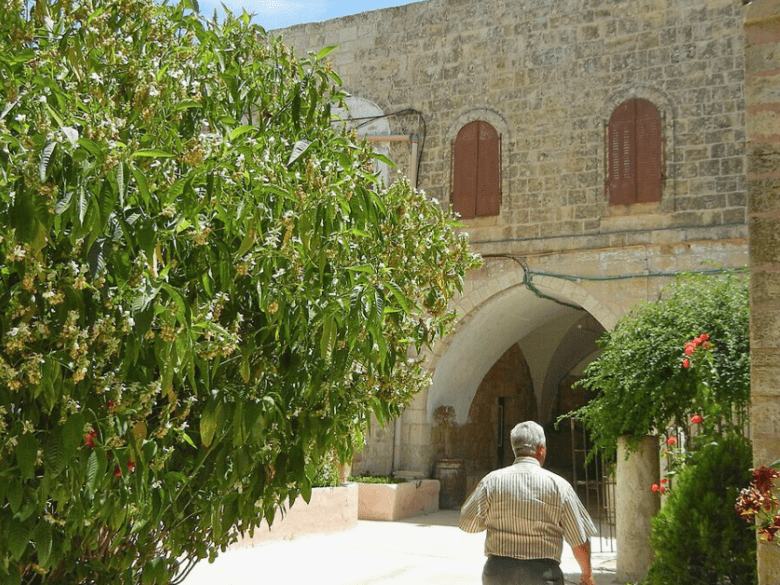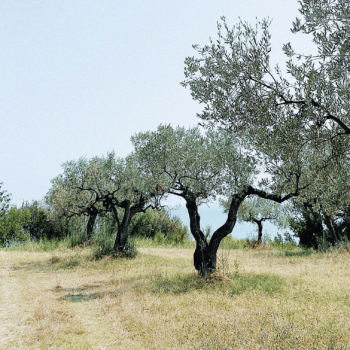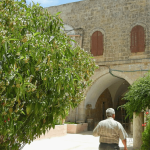In this time of an intensified campaign against Palestinians since October 7th, 2023, the figure of St. George can provide a valuable symbol of the spiritual resilience and interfaith connection of Palestinians. For those of us who venerate saints, he holds a special importance at this moment. In his role as patron saint of Palestinian Christians, we can pray for the whole of Palestine, alongside the work we do materially.
George of Lydda is venerated as an early megalomartyr across Christianity. He is a powerful symbol of connection between the faiths practiced in the region. He is the patron saint of Palestinian, Lebanese, and Syrian Christians. Records of the veneration of the saint can be found as early as the 5th century CE. He is now one of the most venerated saints in Christianity. He is also respected by some Druze and Muslims as a defender of monotheistic faith.
Legends of St. George in Lydda
According to holy tradition, St. George was a man of Cappadocian Greek origin who was a soldier in the Roman army and the Praetorian Guard for the Roman emperor Diocletian. He was executed by decapitation at or near Lydda in Syria Palaestina, and that his body is buried there.
It cannot go unstated that stories of St. George spread through the Crusades, one of the most violent chapters in history. His early veneration begins in Lydda, also known as Diospolis. His story, however, predates these events. The earliest cult of St. George was localized in the traditional site of his execution in 303 CE, Diospolis (Lydda), currently occupied by the State of Israel. A titular church was built during the reign of Constantine the Great, consecrated to “a man of highest distinction.” The church standing in Lydda today was erected in 1872 and rebuilt multiple times. This church houses a sarcophagus traditionally believed to contain his relics.
Over the course of time, stories of his martyrdom have expanded; he is said to have suffered more than twenty separate tortures over seven years. Stories say he converted the Empress Alexandra of Rome, who would also be martyred for refusing to recant her faith. Another well-known legend of St. George includes his slaying of a dragon. This legend is not present in the early hagiographies of the saint, suggesting it may have been a later addition. It was first attributed to him in the 13th century.
Saint George: A Shared Figure
St. George is associated with the Muslim figure al-Khadr, “the green one,” among the Muslim population of the area. Through this association, his veneration in folk piety has been shared with Muslims and Druze in the region alongside Christians. He is included in some Muslim texts as “Jirjis” or “Girgus”.
These texts suggest he lived among a group of believers who were in contact with the last apostles of Jesus. In Muslim legends, he was martyred three times and resurrected each time. In the account of one of his deaths from Ibn al-Athir, his death mirrors that of Jesus. In this account, after St. George’s death, the world is covered in darkness lifted on when he is resurrected.
The Palestinian town of al-Khadr is named after St. George. The Saint’s shared devotion is evident in the shared celebration of the saint among the multiple religious groups of the area. The Monastery and Church of St. George in al-Khadr is considered his most important sanctuary in Palestine.

The monastery has historically attracted both Palestinian Christians and Muslims. Worshippers across Palestine would visit, trade loaves of bread, and make sacrifices. This tradition continued into the 20th century. Muslims have traditionally guarded the entrance of the church and welcomed pilgrims. Members of both communities have shared rituals such as lighting candles and offering oil at the tomb. Some Muslim families have kept the tradition of taking their sons to Saint George’s church in al-Khadr for the priest to bathe them in the water of the font for strength.
Muslims and Christians often prayed together at the Church of St. George in Lydda. The Church shares a wall with the neighboring mosque, cementing the union of these two communities. This exchange of spiritual practice provides a powerful testament to the religious unity in the area, and reminds us that Christians and Muslims there and elsewhere have shared a history and traditions in peace. Sadly, many of these traditions have not been able to continue due to the occupation of Lydda and al-Khadr previously, as well as the destruction caused in the ongoing period of intensified violence.
A Symbol of Resilience and Unity
In 1948, the Palestinian population of Lydda was almost completely expelled by the forces of the State of Israel occupying the area. The Lydda Death March involved the expulsion of 50,000 Palestinians from Lydda and Ramle by the IDF.
One inhabitant who avoided the expulsion, Spiro Munayyer, described the population of Muslims and Christians being rounded up into the Church of St. George and the connected Mosque of al-Khadr before the expulsion.
As we consider shared traditions, we are confronted with the violence and destruction Palestinians have faced since the establishment of the state of Israel. Pilgrims to the Monastery of St. George once gathered under olive trees. This beautiful tradition emphasizes the level of destruction caused by the campaign against Palestinians on multiple fronts; here, the ecocide of Palestine is called to mind.
The military saint extends beyond the simple soldier figure. He is a symbol of resistance and steadfastness, traits we must carry forward while facing the colonial entities of the world that would see Palestine destroyed. The campaign against Palestine is not new.
Remarkably, traditions of the Feast of St. George survived these expulsions, with Palestinians continuing to travel from throughout the country to visit the saint’s tomb. Festivities conclude with a parade of scouts, Christian and Muslim, playing drums and blowing horns down the main street of Lydda. This shared feast has been celebrated for over 1500 years.
The saint sets a powerful example of standing up for one’s beliefs, even under the threat of death. The enduring tradition stands in strong opposition to the narratives of Palestinian violence perpetuated as propaganda to support the occupation of the area and genocide of its people. It instead highlights shared cultural and spiritual heritage, coexistence and co-worship, and mutual respect.







